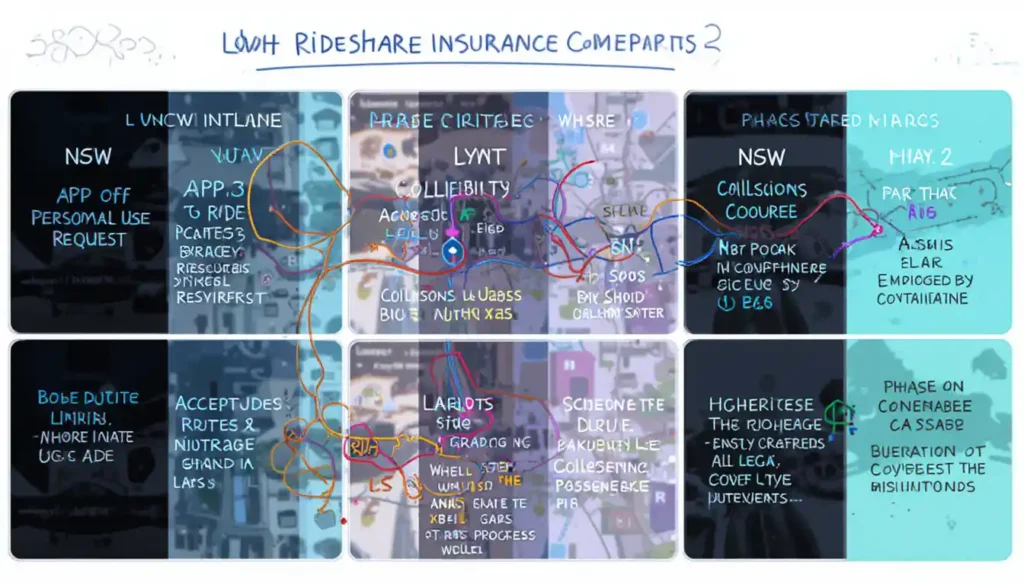Rideshare driving has become one of the most popular ways for people to earn extra income or even make a full-time living. With the rise of platforms like Uber and Lyft, millions of drivers are hitting the road daily, transporting passengers across cities. However, one crucial aspect that many drivers overlook is rideshare insurance.
Most drivers assume that their personal auto insurance or the insurance provided by rideshare companies is enough. Unfortunately, that’s not always the case. Many drivers find themselves in financial and legal trouble due to gaps in their coverage. Understanding rideshare insurance is essential to avoid expensive mistakes and ensure financial protection in case of accidents.In this guide, we will demystify rideshare insurance,
explain how it works, uncover gaps in coverage, and help you choose the best insurance policy. If you’re a rideshare driver in the USA, this article will give you everything you need to know about securing the right insurance for your job.
1. What is Rideshare Insurance?
Rideshare insurance is a specialized auto insurance policy designed for drivers working with companies like Uber, Lyft, and other transportation network companies (TNCs).
Many drivers assume that their personal car insurance will cover them while driving for a rideshare company. However, most personal auto insurance policies exclude commercial activities, which means they won’t cover you if you’re driving passengers for money.
To solve this issue, rideshare insurance bridges the gap between your personal insurance and the insurance provided by rideshare companies. It ensures that drivers are fully protected throughout their rideshare activities.
Read Also: Esports Emberslasvegas – Where Gaming Meets Excitement!
2. Why Regular Car Insurance is Not Enough for Rideshare Drivers
Most personal auto insurance policies have exclusions for commercial driving activities, including rideshare services. This means that if you’re in an accident while driving for Uber or Lyft, your personal insurer may deny your claim because you were using the car for business purposes.
Here’s why personal car insurance is insufficient for rideshare drivers:
- Exclusions for Commercial Use: Insurance companies classify rideshare driving as commercial activity, which is not covered under standard policies.
- Potential Policy Cancellation: If your insurer discovers that you are driving for a rideshare service without informing them, they may cancel your policy.
- Out-of-Pocket Expenses: Without proper coverage, you may be responsible for paying for vehicle repairs, medical bills, and legal fees in case of an accident.
Rideshare insurance is designed to fill these gaps and provide coverage where personal auto insurance falls short.
3. How Rideshare Insurance Works: Understanding the Coverage Phases

Rideshare insurance coverage varies depending on what phase of driving you’re in. Rideshare companies divide the driving process into different phases, each with its own insurance rules.
Phase 1: App Off (Personal Use Mode)
- When your rideshare app is turned off, your personal auto insurance applies.
- There is no coverage from the rideshare company.
Phase 2: App On (Waiting for a Ride Request)
- Limited coverage from rideshare company: Uber and Lyft provide liability coverage only.
- Your personal policy may not cover this phase since you’re technically “on the job.”
- If you get into an accident during this period, you may not have collision coverage unless you have a rideshare insurance policy.
Phase 3: Accepted a Ride & En Route to Pick Up a Passenger
- Rideshare companies provide higher liability coverage.
- Collision and comprehensive coverage apply only if you have these coverages on your personal policy.
- A deductible applies (e.g., Uber’s deductible is $2,500).
Phase 4: Passenger Onboard & Trip in Progress
- This phase has the most coverage.
- Uber and Lyft provide up to $1 million in liability coverage.
- Collision and comprehensive coverage also apply (subject to the deductible).
Phase 5: After Dropping Off Passenger & Returning to Personal Use
- The rideshare company’s coverage ends, and personal auto insurance takes over again.
Without rideshare insurance, there are gaps in coverage during Phases 2 and 3, leaving drivers vulnerable to financial loss.
Read Also: Yezzit.Com Gold – Your trusted platform for gold investment!
4. What Uber, Lyft, and Other Rideshare Companies Cover
Uber’s Insurance Coverage
- Period 1: $50,000 injury liability per person, $100,000 per accident, $25,000 property damage.
- Period 2 & 3: Up to $1 million in liability coverage.
Lyft’s Insurance Coverage
- Period 1: Similar to Uber’s policy, but only applies if personal insurance does not cover the accident.
- Period 2 & 3: Up to $1 million in coverage.
While rideshare companies provide significant insurance coverage, there are deductibles and exclusions that drivers need to be aware of.
5. The Hidden Gaps in Rideshare Insurance
Even though Uber and Lyft provide insurance, there are many gaps that drivers need to be aware of:
- High Deductibles: Uber and Lyft’s deductibles are very high (e.g., $2,500 for Uber), meaning you must pay a large sum out-of-pocket.
- No Coverage When the App is On but No Ride is Accepted: The most dangerous gap in rideshare insurance is Period 1, where only liability coverage is provided.
- Medical Bills May Not Be Fully Covered: If you’re injured in an accident, the insurance provided by rideshare companies may not cover all medical expenses.
To protect yourself from these gaps, getting a rideshare-specific insurance policy is essential.
6. How to Choose the Best Rideshare Insurance Policy
When choosing a rideshare insurance policy, consider the following:
- Coverage Limits: Ensure the policy covers all phases of rideshare driving.
- Deductibles: Choose a policy with a reasonable deductible.
- Cost vs. Benefit: Compare premium costs with the coverage provided.
Some of the best insurance providers for rideshare drivers in the USA include:
- Progressive
- State Farm
- GEICO
- Allstate
Read Also: Myflexbot – Start Claiming Blocks Like a Pro!
7. The Legal Consequences of Driving Without Rideshare Insurance
Driving without proper rideshare insurance can lead to:
- Policy Cancellation: If your insurer discovers you drive for a rideshare company without disclosing it, they may cancel your coverage.
- Out-of-Pocket Costs: If an accident occurs, you could be responsible for thousands of dollars in damages.
- Legal Penalties: Some states require specific rideshare insurance, and failing to have it could result in fines.
8. FAQs About Rideshare Insurance
Is Rideshare Insurance Mandatory?
Rideshare insurance requirements vary by state. Some states legally mandate rideshare-specific coverage, while others do not. It’s essential to check your state’s regulations to avoid penalties or coverage gaps.
Can I Use One Insurance Policy for Multiple Rideshare Platforms?
Yes, most rideshare insurance policies cover multiple platforms like Uber, Lyft, and DoorDash. However, coverage details may vary by insurer. Always confirm with your provider to ensure full protection.
How Much Does Rideshare Insurance Cost?
Rideshare insurance typically costs an additional $10–$30 per month. The exact price depends on factors like your insurer, location, and driving history. Comparing different providers can help you find the best rate.
Conclusion
Rideshare insurance is essential for drivers working with Uber, Lyft, and similar services. While these companies provide some coverage, there are significant gaps that could leave you financially vulnerable in case of an accident. Personal auto insurance alone is not enough, as most policies exclude commercial activities.
Without proper coverage, you risk out-of-pocket expenses, policy cancellations, and even legal issues. Investing in a rideshare-specific insurance policy ensures you’re fully protected during all driving phases. It also provides peace of mind, knowing that your vehicle, finances, and personal well-being are secure. Don’t wait until an accident happens—get the right insurance today and drive with confidence.
Read Also:





